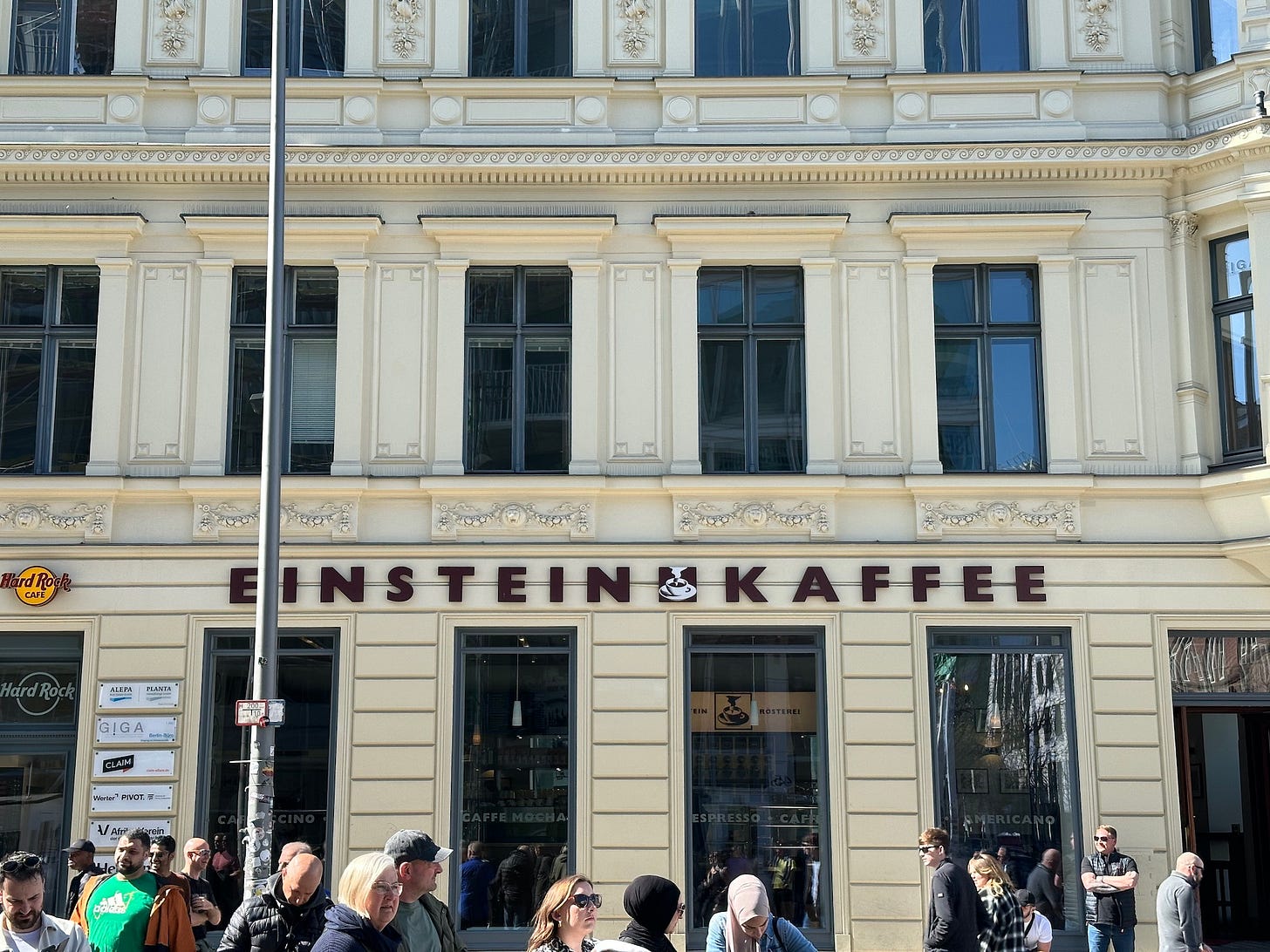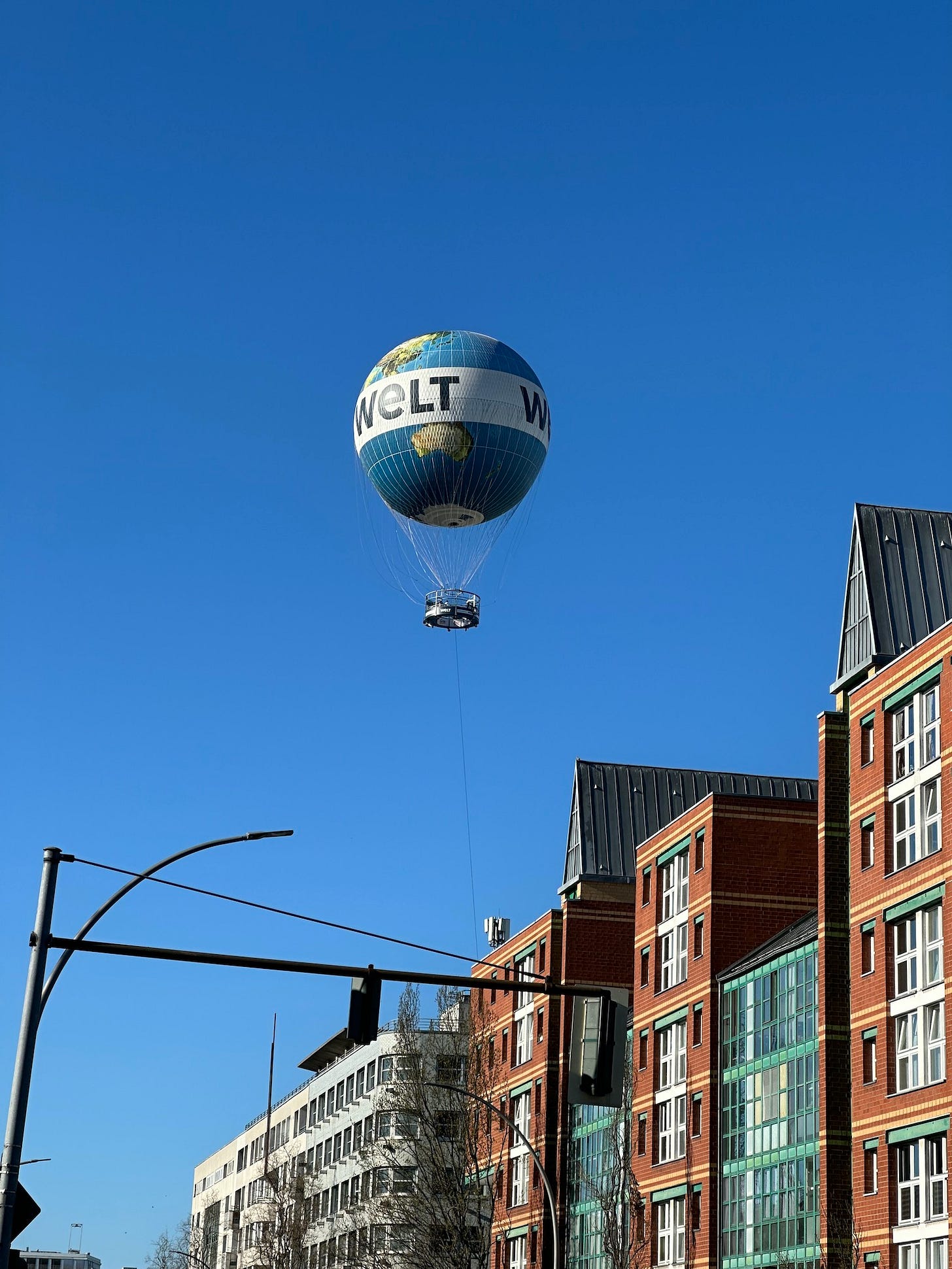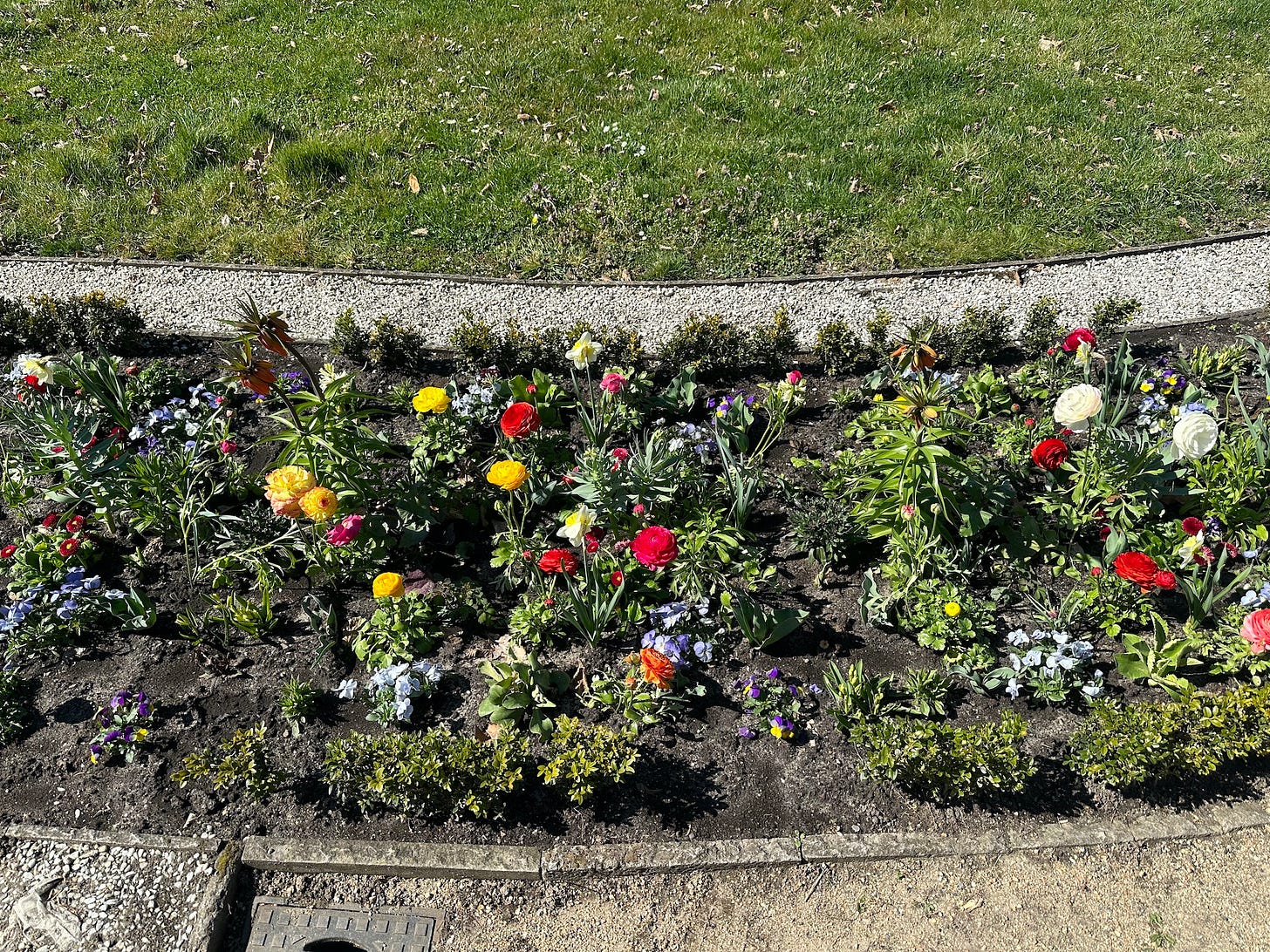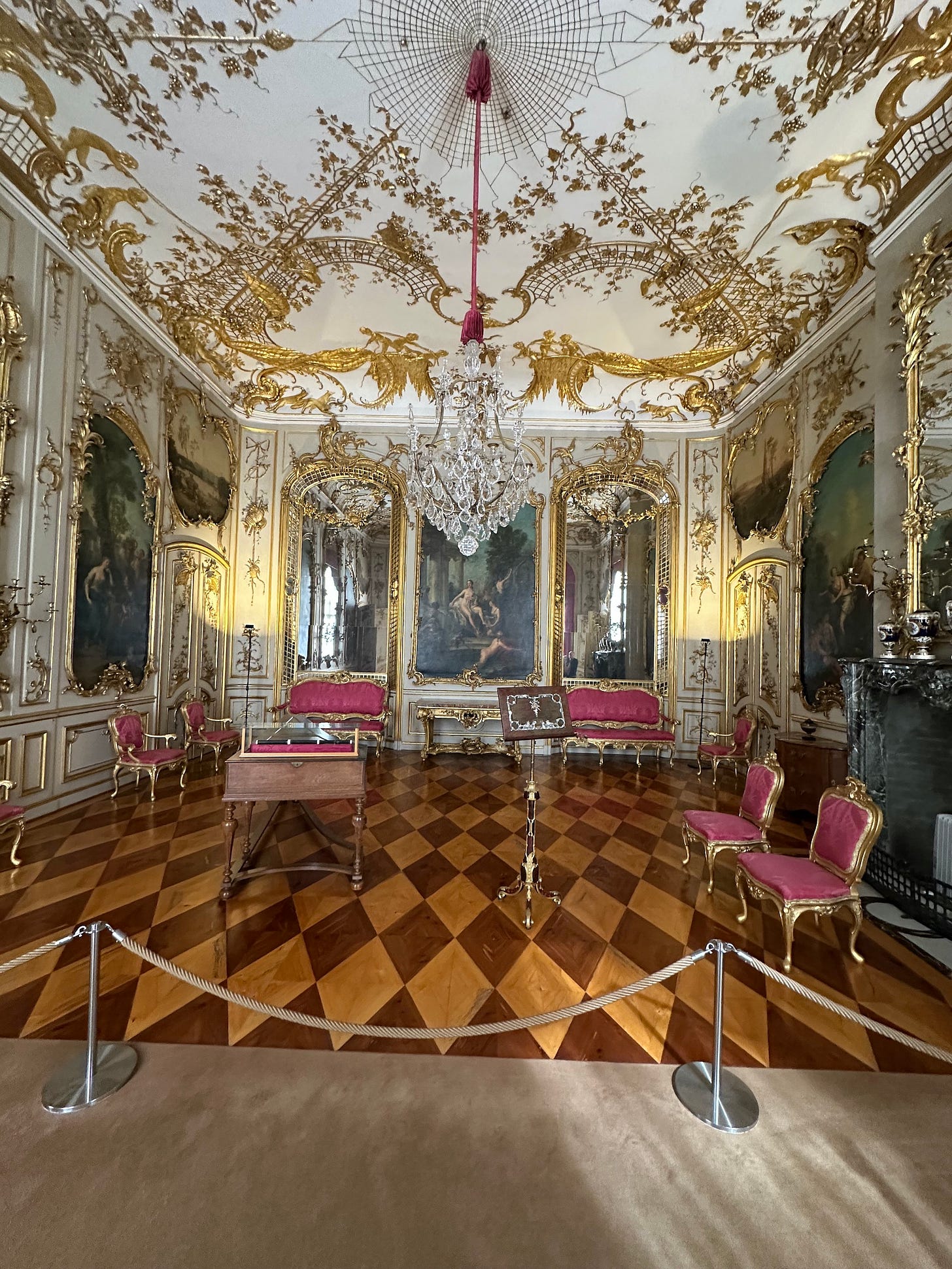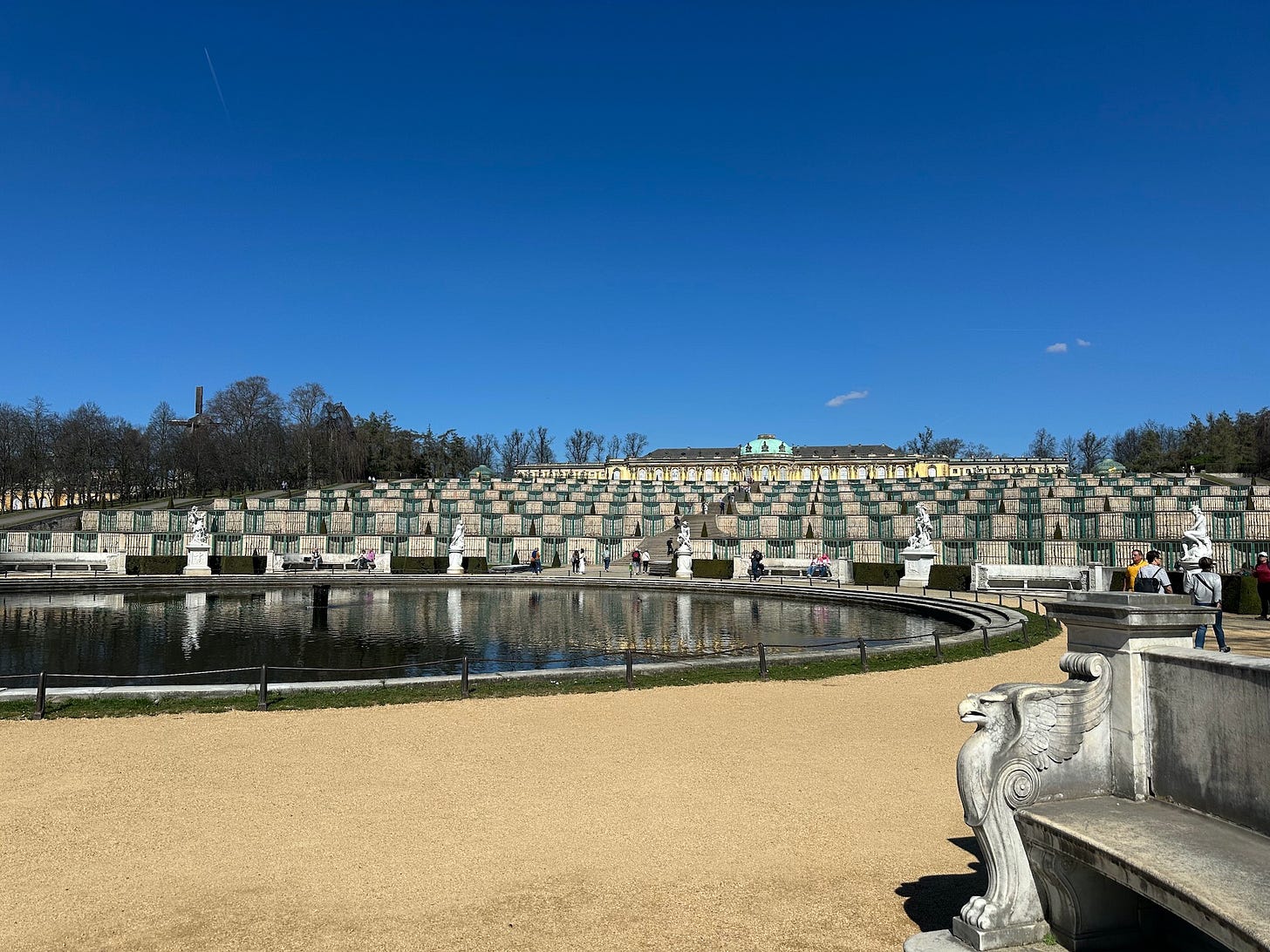My sister attended the Global Disability Summit in Berlin. I went to Berlin on Wednesday, April 2 to see her in the evening (I was not an attendee, so could not see her at the conference). We went to a Mexican restaurant on the Wednesday night and to an Indian one on the Thursday night. What we noted at both places was that we got a bowl of salad even if we hadn’t ordered it (they didn’t charge for it, through). According to my brother this is because then they don’t feel guilty when they eat an oversized schnitzel. Oh well.
While my sister was at the convention, I spent the Thursday walking through a part of the city, which was in the old West Berlin part just south of Checkpoint Charlie1. While Checkpoint Charlie is still clearly marked, and you can still buy bricks from the old Berlin wall, otherwise I couldn’t see any difference between East and West Berlin, as both look quite modern. And I increased my intelligence by having a coffee in the Einstein Kaffee (it’s a chain…;-).
The convention ended with a house party—well, it’s in Berlin, after all, which is famous for its club scene—that was free and open to everyone (also people who didn’t attend the convention). Several dance floors—obviously accessible to all—s fashion floor, an inner plaza and a quiet room with a paytronic installation where electrodes were inserted in fruits and vegetables, which one could then squeeze for sounds2.
Also, at the end of the convention, the Amman-Berlin Declaration on Global Disability Inclusion was made: the 15% for the 15%; that is, to ensure that 15% of international development programs implemented at the country level pursue disability inclusion as an objective3. Not to put a too fine point on this: the King of Jordan, a muslim, donated funds for charitable goals: he founded the King Hussein Foundation (2023 annual report here), and co-hosted the Global Disability Summit with Germany and the International Disability Alliance. The current president of the US—who is basically holding ethnic cleansings against muslims and other foreigners—has not donated a single cent of his own money to a charity4 in his whole life. Enough said.
Berlin is like many other European cities: multicultural, diverse with plenty of international and vegan restaurants, and many good coffee venues5 (even if these can be—as in The Netherlands—quite pricey). Also with lots of shops for souvenirs and local delicacies. My sister was hoping we’d run into a typical German chocolate shop so that she could bring German chocolates, bonbons or pralines to her friends in Australia. This amused me, as the European countries famed for their chocolates are Belgium and Switzerland. And indeed, the chocolate shops we encountered in Berlin featured mostly Belgian or Swiss chocolates. Then we thought we finally found a typical German one. But no, Neuhaus—which is really a German name—are from Belgium. I learn something new every day.
After seeing it featured in the Korean drama Queen of Tears, my sister wanted to visit the Palais Sanssouci in Potsdam (which is some fifty kilometres east of Berlin). She still had a barcode for free transportation that she received as an attendee of GDS, while I had to pay €12 for the return trip (which is relatively cheap). Some of you might find the that the name of the palace sound French, and that is because it is. During King Frederick the Great6’s time, France was popular—the ‘flavour du jour’ if you wish—and French was the lingua franca—King Frederick spoke fluent French, he spoke it better than his native German.
The Palais Sanssouci was one of the German rivals of Versailles, and while it was smaller than the French original—its garden a mere 290 hectares compared to Versailles’s 800—it was too big for us to cover, as we had an evening flight to catch.
While I appreciated the fact that King Frederick allowed anybody who was ‘dressed properly’ to visit this palace in his absence, I found its rococo style7 rather overblown and the excessive use of (fake) gold paint quite tacky. Let’s just say that this 18th Century style didn’t quite fir my modern sensibilities. On top of that, the profuse superlatives in the audio tour were exaggerated enough to make me roll my eyes as it exceeded my quote—actually tolerance—for purple prose by a large margin.
As it was early April, the wine vines of the terraces were still bare (see picture below), while many flowers were in blossom (ibid). We also went to the so-called Chinese House, which was an impression of how Western Europeans thought China was (not many people could travel to China in those days)
At the end of the afternoon, we have some tea/coffee and German cakes, and then made our way to The Netherlands via Berlin, Brandenburg Airport and Schiphol. I quite liked Berlin, but won’t be visiting Palais Sanssouci in Potsdam again.
Support this writer:
Like this post!
Re-stack it using the ♻️ button below!
Share this post on Substack and other social media sites:
Join my mailing list:
Author’s note: while I’m still working on ongoing copy-edits, I wonder about Substack, which is evolving fast. I joined more than two years ago because it was a medium8 for writing words (blog posts, essays, fiction, poetry and whatnot). Increasingly, it’s becoming a multi-media platform, as I see podcasts and even music in some of the feeds I follow, and a lot of video posts. Most videos are like podcasts where you can see the speaker(s) talk.
Well, I didn’t join Substack for that—I want to read (and produce) the written word. I don’t mind videos, but I thought TouTube, Vimeo et al were for that. Similarly, I don’t mind podcasts—I’ve had two of my stories featured on Escape Pod—but they have their own platforms, as well. Each to their own9.
Yet I prefer the written word because:
I can take in information much faster reading rather than watching and/or listening;
Writing something down forces people—if they do it right—to be more concise than when they’re talking about it (with all the pauses, repititions and inadvertent noises that go with it);
A well-written piece stays much longer with me than a podcast or video10;
I know, Substack wants to expand its reach—a recent post metioned more than 5 million creators on the platform—yet I sincerely hope that all the good writing doesn’t get lost in an avalanche of podcasts and videos. And that apart from the ongoing deluge of AI-generated content11.
Keep reading people, and keep writing. I believe we are still fighting the good fight.
Which was, if I’m correct, the American Zone;
And now the Triffids will invade. We’re doomed…;-)
The other 15% is the number of disabled people of the global population. Unfortunately, my sister is one of them;
Even worse, he set up the Donald J. Trump Foundation (a tax-exempt private foundation) for the stated purpose of distributing the funds to charitable causes. But in reality, this foundation was used for his business and political purposes (translation: nothing went to charities as this foundation was used to avoid taxes). Only after being ordered to do so by the court, almost $2 million was paid to eight charities as the foundation was dissolved. It was a scam from the start, just read the linked Wikipedia entry;
And I do mean coffee, as I don’t use cannabis;
Who had it built—it was his summer residence;
Supposedly more ‘intimate’ than the baroque style of Versailles;
Pun intended;
And I’m partly guilty, as well, when I include video links in my posts that rank music. Nevertheless, these pieces are mini-essays, opinion pieces about music, where the videos are meant as illustrations (like the pictures and art I often include in posts), and not as the main programme;
Quality movies and great music excepted, but those are not on Substack;
'Prompt engineering’ is a thing now. I still find that writing it down myself—even after several rewrites and edits—is still faster and multitudes better than trying to ‘prompt’ an AI into prducing something with a soul (which they still can’t, thank dog);





